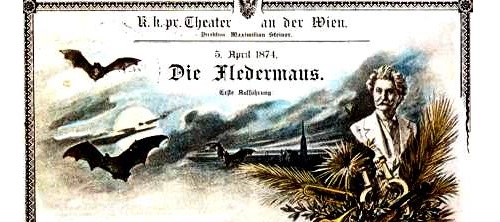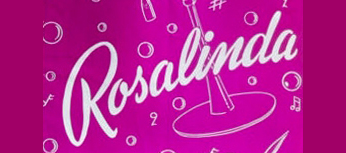Pas de biographie disponible.
Compositeur Musique additionelle Librettiste Parolier Metteur en scène Chorégraphe Producteur création Producteur version

Opérette
Musique: Johann Strauss II • Paroles: Richard Genée • Livret: Carl Haffner • Richard Genée • Production originale: 5 versions mentionnées
Dispo: Résumé Synopsis Génèse Liste chansons
Die Fledermaus est sans conteste le grand chef-d’oeuvre de Johann Strauss et l’opérette viennoise par excellence. Sur fond de désastre économique et social, Strauss compose, en 1874, cette oeuvre emplie d’allégresse et de vitalité, dans laquelle airs brillants et valses, certaines parmi les plus célèbres du répertoire, dominent la pièce. Les personnages se retrouvent au coeur d’un bal masqué à Vienne, et sous son déguisement, chacun recherche l’ivresse et l’exaltation de l’amour et de la séduction. Après plusieurs quiproquos et supercheries, tous s’entendent pour blâmer le « Roi Champagne », cause de toutes les incartades. L’oeuvre, adaptée d’après la pièce française Le Réveillon, est traditionnellement jouée à Vienne, chaque année, le soir du 31 décembre.
Genèse: Die Fledermaus (en français, La Chauve-Souris) est une célèbre opérette viennoise de Johann Strauss II composée en 1874 et créée au Theater an der Wien de Vienne le 5 avril 1874. À la base du livret, une pièce autrichienne de 1851, Das Gefängnis (La Prison) adaptée par Henri Meilhac et Ludovic Halévy en 1872 sous le titre "Le Réveillon". L'œuvre retourne à Vienne, où l'histoire est transformée par Richard Genée et Karl Haffner. Strauss achève la partition en 42 jours. Créée en français à Paris le 30 octobre 1877 sous le titre La Tzigane, dans une version remaniée de Delacour et Wilder, elle ne rencontre le succès qu'à partir de 1904 dans une nouvelle adaptation de Paul Ferrier.
Résumé: Gabriel von Eisenstein doit aller en prison y purger une courte peine pour outrage. Son ami Falke lui conseille de se rendre malgré tout, et à l’insu de sa femme Rosalinde, au bal masqué du prince Orlofsky. Rosalinde a prévu de recevoir entre temps son amant Alfred. Mais ce plan est contrecarré du fait qu’ Alfred est écroué par le directeur de la prison à la place d’Eisenstein. Rosalinde se rend elle aussi au bal d’Orlofsky… où Eisenstein met tout en oeuvre pour séduire une beauté inconnue, masquée qui lui subtilise sa belle montre. Le lendemain, Eisenstein s’annonce à la prison où Alfred est enfermé à sa place. Et les relations étranges sont toutes élucidées : il apparaît qu’Eisenstein a séduit sa propre femme (ce que prouve la montre). On passe l’éponge sur cet épisode et le champagne est déclaré coupable de tout…
Création: 5/4/1874 - Theater an der Wien (Vienne) - représ.

Opérette
Musique: Karl Millöcker • Paroles: Rowland Leigh • Livret: Camillo Walzel • Richard Genée • Production originale: 1 version mentionnée
Dispo: Résumé Génèse
Genèse: During the years of his musical maturity in the 1880s, Carl Millöcker (1842 - 1899) was regarded as an operetta composer in the same class as Johann Strauss II and Franz von Suppé. Indeed, it was Suppé who recommended his colleague as a conductor to the Thalia-Theater in Graz in 1864. Millöcker, who had been trained as a flutist at the Vienna Conservatory from 1855 to 1858, moved about considerably as he established himself, first as a conductor, and later as a composer of operetta. While at first, Millöcker wrote one-act works similar to those of Offenbach, he subsequently turned to composing full-length operettas. Of all his successful stage works, Der Bettelstudent (1882) has maintained the firmest hold on the public's affections. Gräfin Dubarry (1879), set to a libretto by Zell and Genée, was not a major success. It nevertheless contained some quite beguiling music, notably the arias composed for the heroine, based on an actual historical French countess who was a favored mistress of King Louis XV. From her exceedingly modest start as a millinery worker, Jeanne (as she is known) rises to celebrity as a Parisian dancer and singer. In "Ich schenk mein Herz" (I Offer my Heart) she recounts the joys and disappointments of love and expresses her resolve to give her heart to one special man only, be he slave or king. Another aria beloved of operetta sopranos is "Was ich im Leben beginne...Ja so ist sie, die Dubarry" (When I begin a thing in life...Yes, that's what she is like, this Dubarry). Often referred to as "Jeanne's Song" (especially when sung in English translation), this aria offers a buoyant opening and close brightly enfolding a glowing 3/4 time center section, first reflective, then ecstatic as the countess Dubarry describes the fire of her kiss for the right man. While the work in toto has been poorly represented on disc, several prominent sopranos have essayed these two memorable sections from the score -- most notably Elisabeth Schwarzkopf, who set an intoxicating, unsurpassable standard in a 1957 recording of operetta arias. However modest the acclaim extended to the original work, Dubarry achieved considerable popularity when, in 1931, the best portions of the score were appropriated for a pastiche by Theo Mackeben, presented under the title Die Dubarry. In this form, set to an entirely new libretto, Millöcker's music achieved the same widespread performance and acceptance as that enjoyed by his most successful works of the 1880s and 1890s (such as Der Bettelstudent. The revision was frequently produced and very well received throughout Europe, England, and North America.
Résumé: The young milliner, Jeanne, quarrels with the hat-shop owner, Madame Labille, and, unemployed, has to rely on her poet-lover, René Lavallery, for financial support. However, the Comte Dubarry entices her away from the poet’s garret to the Maison Dubarry. Even higher “honours” are on offer, for the Maréchale de France, makes it clear the King is very interested in Jeanne, the “Madame Dubarry”, and is willing to pay the Comte’s debts for a consideration. The Comte is only too ready to make a deal - it seems there are many pimps and procurers at the court of Louis Quinze - and the upshot of it all is, of course, that Madame Dubarry becomes the uncrowned Queen of France.
Création: 31/10/1879 - Theater an der Wien (Vienne) - 397 représ.

Musical
Musique: Johann Strauss II • Paroles: Paul Kerby • Livret: Carl Haffner • Richard Genée • Production originale: 1 version mentionnée
Dispo:
Die Fledermaus (La chauve-souris) () de Johann Strauss a été créée le 5 avril 1874 au Theater an der Wien, en Autriche, et est devenue l’une des opérettes les plus populaires jamais écrites. Les mélodies luxuriantes de Strauss sont parfaitement liées à l’histoire légère d’un mauvais comportement amoureux, de tromperies conjugales et d’identités erronées. L'œuvre a été jouée à New York de nombreuses fois en allemand et en anglais mais il faut compter aussi un certain nombre d’adaptations américaines notables dont adaptations: The Merry Countess (Casino Theatre, 20/8/ 1912 - 135 représentations - adaptation de Gladys Unger, paroles de Arthur Anderson); A Wonderful Night (Majestic Theatre, 31/10/1929 - 125 représenttions - adaptation de Fanny Todd Mitchell) et Champagne, Sec (Morosco Theatre, 30/10/ 1933 - 113 représentations). Rosalinda est de loin la version américaine la plus réussie, avec un total de 521 performances.
Genèse:
Résumé:
Création: 28/10/1942 - 44th Street Theatre (Broadway) - 521 représ.